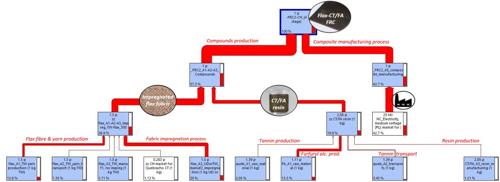Life Cycle Assessment of a full bio-based composite and associated economics
- Degree programme: Master of Science in Wood Technology
- Author: Guillaume André
- Thesis advisors: Dr. Christelle Ganne-Chédeville, Prof. Dr. Ingo Mayer
- Industrial partner: Faserplast Composites AG Rickenbach TG
- Year: 2022
Flax fibre reinforced composites with a tannin-based matrix (Flax-CT/FA FRC) were identified as a more environment-friendly alternative to glass FRC with a phenolic matrix (Glass-PF FRC), for a use as indoor train panels. A well chosen Flax-CT/FA design showed its ability to decrease the Global Warming Potential in a variable range from 4 % to 24 % (vs Glass-PF) depending on the train traction electricity mix, while increasing the production cost by 58 % due to raw materials.
Objectives
The study had to define how to assess the Flax-CT/FA composite's environmental footprint and economics compared to the reference composite (Glass-PF FRC), and highlight their relative positioning on key indicators.
Methodology
A Life Cycle Assessment (LCA) and a Life Cycle Costing (LCC) were conducted to compare different designs of Flax-CT/FA FRC to the Glass-Phenol FRC as a reference. The LCA functional unit was defined as "1 m² flat fibre reinforced composite having a minimum bending stiffness of 11.8 kN.mm², manufactured at Faserplast Composites in Poland, and used as an indoor panel in an InterCity train operated during 30 years in Switzerland or in Germany, and incinerated at its end-of-life". The Global Warming Potential 100 years from IPCC 2013 method (GWP100a) was taken as the main indicator. Simapro and ecoinvent 3.6 were used to build the LCA models and perform the impact assessments (Figure 1).
The LCC addressed the production costs and the operating costs during the use stage.
Key results
Compared to the reference, the 5 layers composite design based on a Twill flax fabric allowed a decrease of the GWP100a between 10 % and 24 % in Switzerland and only around 4 % in Germany due to the more emissive electricity mix (Figure 2). However, an increase of production costs by 58 % was estimated while providing unsignificant cost saving for the railway operator.

